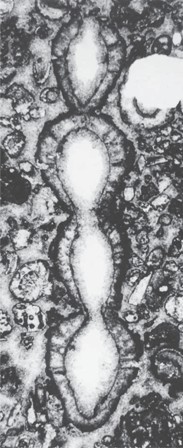Lithocodium and Bacinella signature of a late Hauterivian, local microbial event: the Urgonian limestone in South-East France
Main Article Content
Abstract
Sediment binding crusts of Lithocodium aggregatum and associated Bacinella irregularis abound in a shallow water limestone layer, in South-East France. The sudden appearance of these crusts denotes a local, conspicuous change in the otherwise balanced, open marine depositional environment. Based on regional correlations, the layer is Lower Hauterivian, Ligatus Zone, directly dated by an assemblage of orbitolinids, and indirectly by a specimen of ammonite. It is older than the Faraoni OAE (latest Hauterivian, Angulicostata auct. Zone), and presumably not linked with a global climate change. Two facies are recognized: (1) Lithocodium bindstone, with Bacinella, other microencrusters, and fluorescent automicrite of microbial origin; (2) floatstones containing numerous fragments of Lithocodium and accompanying biota. Coarse rhomboedral dolomite is locally present. Two modern analogues of microbial mediation are put forward to explain the Lithocodium event: (a) Lagoa Vermelha, in Brazil, along with anoxic, marginal marine conditions; (b) Highborne Cay, in the Bahamas, along with oxic, open marine conditions. A stack of four, Upper Hauterivian parasequences is described: Parasequence 1 ends with oolitic deposits; the somewhat deeper water Parasequence 2 occurs only in the south-eastern part of the study area, towards the direction of the Subalpine depotcenter; Parasequence 3 matches the layer with Lithocodium and Bacinella, with wide thickness variations (0.8 m - 11 m), resulting from a syn-sedimentary tectonic activity in the area of a major feature, the Vuache fault system. Parasequence 4 finally corresponds to the resumption of the normal, Urgonian carbonate factory.
Downloads
Download data is not yet available.
Article Details
Issue
Section
Original Scientific Papers
Authors have copyright and publishing rights on all published manuscripts.

